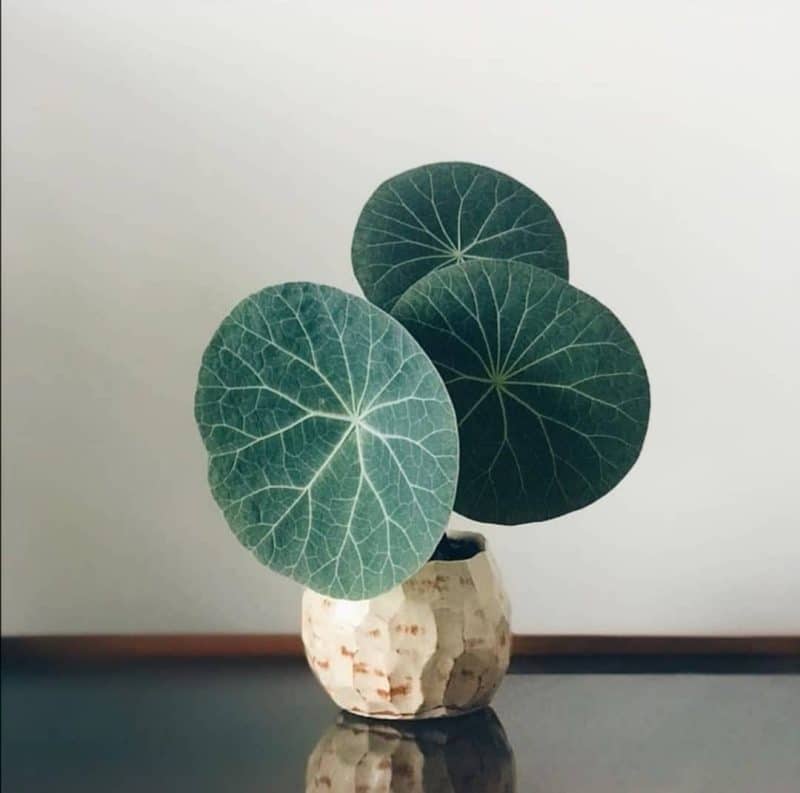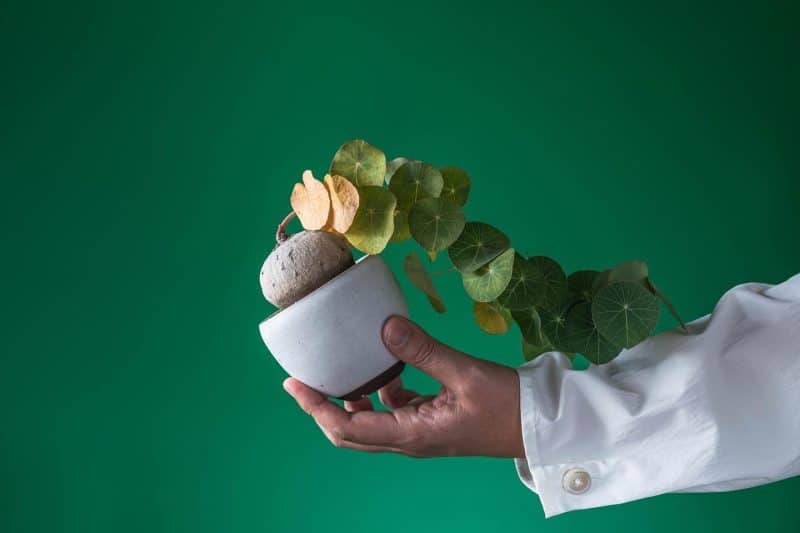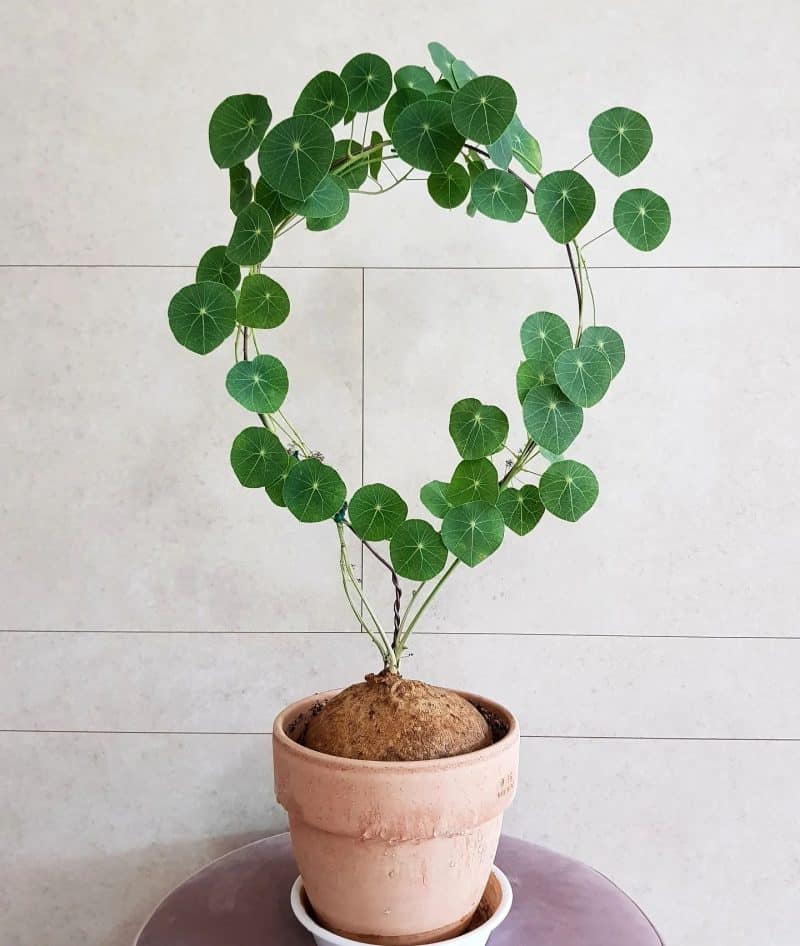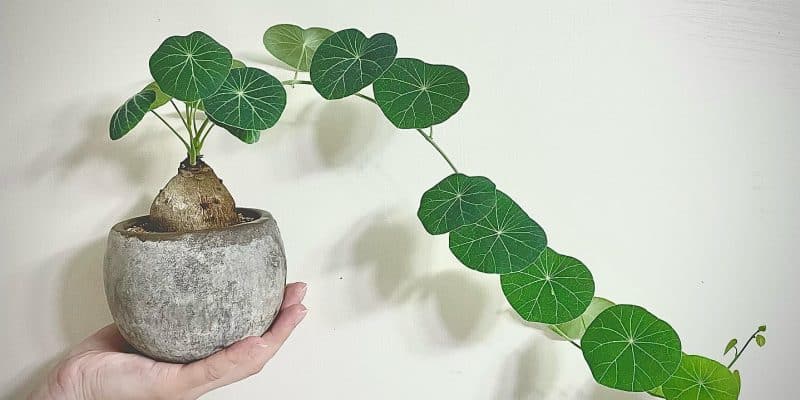Let’s address the elephant in the room: the Stephania erecta basically looks like a giant potato.
Native to southeast Asian forests, Stephania erecta (S. erecta) used to be a rare plant that has relatively recently become the internet’s latest obsession.
Why? It’s just a potato, right? Not for long.
In the proper humidity, and with a little bit of care, the Stephania erecta will sprout a spiral arrangement of tall green stems adorned with shield-shaped, white-veined leaves in a mosaic pattern.
In this article, I’ll cover how to grow your own, propagate more from seeds for your friends, and how to deal with the most common issues (brown and yellow leaves? caudex exposed or not?). Let’s go!
Table of Contents
Stephania Erecta Care Guide

History, habitat, and characteristics
First described by British botanist William Grant Craib in 1922, the Stephania erecta is a caudiciform (plant that shares an aboveground root called a caudex) originally from the forests of Thailand. The plant can be found in Laos, Vietnam, and Cambodia as well.
“Stephania” translates to “crown” from the Greek and refers to the crown shape of the anthers, the part of the plant in its flowers that holds pollen.
Twenty years after its discovery, S. erecta was renamed after French botanist Jean Baptiste Louis Pierre, but the new title never really caught on. Stephania erecta’s updated scientific name is actually Stephania pierrei (S. pierrei).
You may also hear this specimen called the potato plant. When you take a look at the brown bulb at its base, called the caudex, it’s not hard to see why. The Stephania erecta’s caudex looks exactly like a potato and can grow up to seven inches wide.
The leaves grow up to two inches wide on creeping vines, developing a map of notable white veins that can eventually reach a height of three feet.
In order to protect its fragile leaves, the Stephania erecta caudex plant is often sold as just a “potato” with no greenery, also known as a dormant caudex. It’s up to you to activate your potato plant.
Be prepared for a wait once your S. erecta sprouts, though—it can take up to 20 years to fully mature.
Now let’s cover how to activate a Stephania erecta so that it sprouts.
How to Sprout a Stephania Erecta
Most Stephania erecta are sold as just a caudex, or a “potato” with no stems, ready for planting. This is perfectly normal – the caudex is dormant, and it’s your job to wake it up. From this caudex will sprout many thin stems that grow delicate leaves shaped like shields.
Watching your Stephania erecta sprout might be one of the most exciting parts of owning the plant, but it does take patience. Here are some easy steps to ensure your plant blooms quickly:
- Soak your plant’s caudex in warm water for 24 hours to wake it up, just like a seed or a nut. You’ll notice that one part of the caudex has a small ring at the end with a bump, or node. This is the part the stalks will sprout from, so you want to make sure it’s facing up.
- Fill fill two-thirds of your chosen pot with soil, optionally adding a thin layer of rocks at the bottom to help the plant drain. You’ll want a well-draining soil, we’ll cover the ingredients to use in a bit.
- Put the caudex at the top without burying it in the soil. A fully buried caudex is more susceptible to root rot.
- Use a germination dome (you can make it yourself) to give the Stephania erecta more humidity and jump start its growth. To construct a germination dome, water the soil your plant is in until it’s moist but not drenched, then put an unsealed plastic bag on top. This seals in moisture and can help your potato plant sprout more quickly.
- Be patient – a dormant Stephania erecta can take anywhere from one or two weeks to three months to sprout, depending on humidity level and other factors.
It may seem like nothing is happening, but the potato plant’s root system may develop behind the scenes (or in this case, under them) before any foliage. Little green shoots will be the first visible sign that your potato plant is awake and growing.
Remember: the more humidity it receives, the more quickly it will grow, but over watering is still a risk, which we’ll cover in the next care sections.
Read on for the optimal lighting, water, temperature, and soil conditions to help your plant thrive.
Lighting

Stephania erecta requires bright indirect light for at least six hours of the day. This mimics its natural habitat in a forest with light filtered by tall tree leaves. So make sure to avoid direct sunlight, since it will burn the plant’s tuber and leaves.
You’ll want to keep your S. erecta about three feet from a window, or if that’s not possible, cover the window with a sheer fabric to lessen the intensity of direct sunlight.
Your plant will show you it’s receiving a healthy amount of light when it you start noticing short stems sporting large leaves.
Water
Stephania erecta is super easy to over water because its caudex holds moisture, sort of like a camel’s hump. Under watering is much less of an issue.
If your Stephania erecta caudex plant seems dry during while you’re waiting for it to sprout, feel free to mist it sparingly with a spray bottle. Otherwise, let the soil dry out entirely before watering. This means waiting around 2 weeks between waterings in most climates.
If you’re not sure whether your potato plant needs water, stick your finger 2-3 inches into the soil. If it’s dry, get out the watering can.
(Tip: If you want to increase the speed of your potato plant’s growth, consider mixing vitamin B1 and Alpha Naphthalene Acetic Acid (ANAA) with the water you use.)
In winter, roughly from December to April, S. erecta usually goes dormant and requires less water. During this time period, you can cut back watering to around once a month. You might also notice leaves falling off and yellowing, this is perfectly normal.
Temperature and Humidity
Like you and I, Stephania erecta enjoys common household temperatures between 60-80 degrees Fahrenheit. You’ll know when your potato plant is too cold because its leaves will start browning and drying out.
Outdoors, it prefers USDA growing zones 10-11.
Stephania erecta loves humidity and thrives at 60-80%. Fortunately, there are a few different ways to achieve this humidity without turning your home into a sauna.
- Use a spray bottle to mist your plant’s leaves.
- Place your plant in a naturally humid environment like a kitchen or bathroom.
- Make your own humidity tray with rocks and water.
- House your plant in a terrarium or cloche.
- Set your plant near a humidifier.
Soil and Planting
Stephania erecta needs a well-draining soil mixture because its caudex (the woody bulb) stores moisture, meaning the soil needs to retain less water.
As this plant prefers a pH of 6-7 I recommend one of the following potting mixes:
- A sand-based succulent or cactus soil blend. This has the appropriate mix of perlite, grit, compost, and sand to help the plant’s soil drain; or:
- A soil mix of at least 50% perlite, pumice, or vermiculite.
- Optional: A layer of small rocks to help aid soil drainage even more.
Dormancy
Stephania erecta is a deciduous plant that goes dormant in the winter. During this time, you might notice crispy leaves that turn yellow and fall off. Don’t worry—this is a normal process that helps the plant conserve its resources for the upcoming growing season.
When this occurs, keep the potato plant in a dry and warm place and don’t water it more than once a month.
When it’s time for your Stephania erecta to begin growing again at the end of spring:
- Increase the temperature and amount of indirect sunlight.
- Water the plant thoroughly once.
- Wait weeks or months for telltale green sprouts.
Propagation guide

Propagating a Stephania erecta is a little different than most indoor plants because you’ll be using a seed propagation technique.
Seed propagation:
You’ll first need to harvest some seeds, and I really recommend this video on seed harvesting from The Root Culturist:
He covers the entire process from pollinating to obtaining seeds. Basically: when the seeds are black and forming ridges, they’re ready to harvest and you can gently nudge them off your plant. After you’ve collected seeds, you’re ready to grow some new houseplants!
If you aren’t seeing seeds yet, you might just have to wait a bit longer. Most Stephania erecta plants produce seeds for harvesting within two months of planting.
Now that you have some seeds, let’s walk through propagation.
- Soak the seeds in water in a warm and dark place for 24 hours.
- Plant them approximately 0.2 inches into the same composition of soil potting mix for your adult plant.
- If you need to create additional humidity, place an unsealed plastic bag over the top and wait until the seeds start to sprout the plant’s roots. This shouldn’t take more than 1-2 weeks.
- Repot the baby plants after they grow two leaves.
Harvesting and storing bulbs
To harvest and store Stephania erecta bulbs, wait until the plant is dormant with no foliage. Water the soil to make it more pliable, then remove the bulb. Place it into a mesh bag in a dry location with good ventilation.
The bulbs can stay there until it’s time to replant in the late spring.
Common Issues
Once your plant has sprouted, you’ll want to make sure it thrives. The biggest mistake plant owners make with an indoor Stephania erecta is overwatering.
Underwatering your plant and placing it in direct sun are also common mistakes to avoid.
Yellow or brown, wilted or crispy leaves. If your potato plant’s leaves turn yellow and begin to wilt but do not fall off, this could be a sign of overwatering or underwatering. If your plant is wet, stop watering it immediately and make sure it has well-draining soil and a pot with large enough drainage holes.
If the potato plant doesn’t show signs of excess water, it might need more light.
Note that this should not be confused with the plant’s dormancy period, which is a natural occurrence around wintertime. Stephania erecta leaves will turn yellow and fall off during this time.
If your plant is dry, give it a thorough watering. Consider misting the caudex and leaves when they seem dry to create more humidity.
Brown, curling leaves. The Stephani erecta plant doesn’t tolerate direct sunlight. This will scorch its caudex and leaves, causing them to brown and curl. Ensure your plant receives only bright indirect light, several feet from a window or weakened by a sheer fabric.
Long stems and small leaves. The Stephania erecta needs indirect light to thrive. If it has noticeably long, weak stems with small leaves, that means they are etiolating, or growing without enough light. Move your plant to an environment with more sunlight, or consider using artificial light or LED lights.
Diseases and pests
If your plant is doing well, you probably won’t come across any of these issues, and for a tropical plant, the Stephania erecta isn’t terribly difficult when grown indoors.
Root rot
The quickest way to kill your S. erecta is to bury it entirely in soil, where it runs the risk of soaking up too much water and rotting. Overwatering it can also cause root rot.
If you experience root rot, stop watering, prune the affected parts, and replant the healthy ones in a new pot with fresh soil mix.
Rust fungus
Too much moisture on leaves can cause rust fungus, resulting in leaf spot disease and mildew.
If you experience rust fungus, stop watering and prune the affected leaves immediately.
Common pests
Tiny insects tend to plague the potato plant, including spider mites, whiteflies, aphids, and mealybugs.
Neem oil is the best solution to insect infestations. Combine a one-quart mixture containing:
- One teaspoon of dish soap
- Two teaspoons of neem oil in a spray bottle
- Water
Spritz every part of your potato plant, including under its leaves and the surrounding soil. You can repeat this process every 5-8 days if necessary.
Conclusion
Stephania erecta is a rare plant that has captured the eye of growers everywhere. The contrast between plump potato bulb and elegant white-veined leaf cluster is what sets the plant apart.
The S. erecta needs humidity, indirect light, and a well-draining soil mix to flourish. It goes dormant in the winter and loses its foliage.
S. erecta is a plant for the patient, since it can take up to three months to sprout and over 20 years to mature. But keep in mind that the more humidity it has, the faster it will grow.
With great patience comes great rewards. The potato plant is a fun challenge and totally worth the time it takes to cultivate.
FAQ
How do you collect Stephania erecta seeds?
You can gather S. erecta seeds from a pollinated plant in late summer.
When the seeds develop slight ridges and turn black, they are ready to be scooped up. They will either fall off the vines themselves, or you can gently nudge them.
From pollination to gathering, the process takes about two months. Dry them out and they’re ready to sow!
Is the Stephania erecta rare?
Stephania erecta is a relatively rare plant, but has become increasingly popular.
Does the Stephania erecta have flowers?
Yes. When exiting its dormant period, Stephania erecta will usually produce small yellow flowers.
Which side of the bulb is up?
One end of the bulb, or caudex, has a small bumpy ring called a node. This is where stems will eventually sprout from, so it should always remain up.


